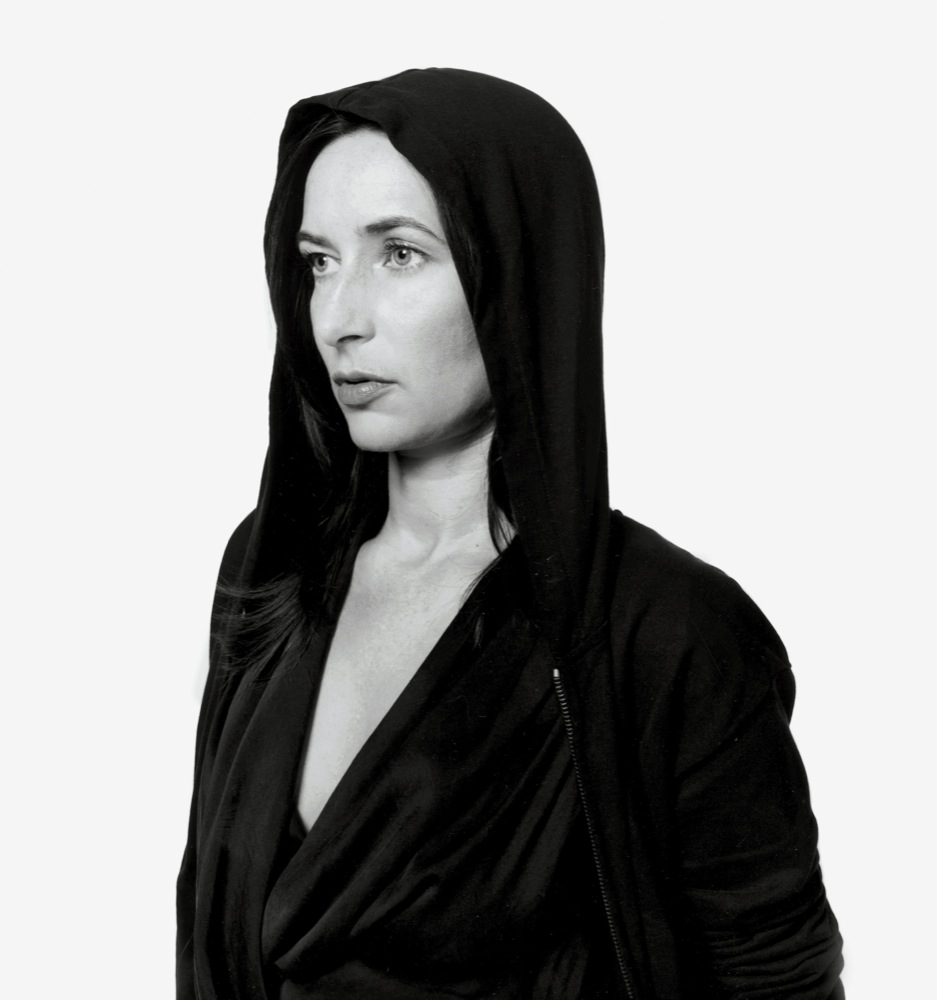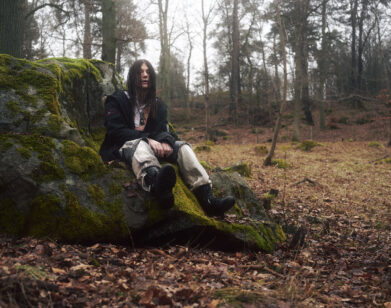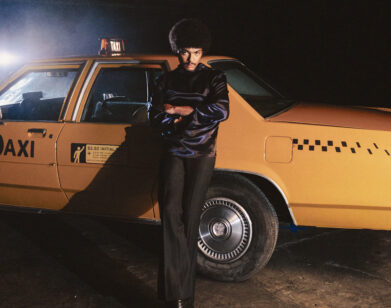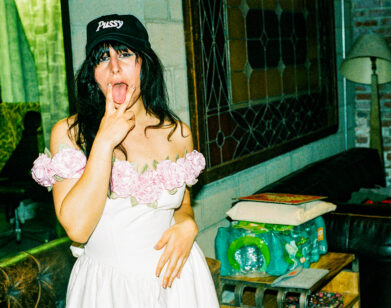Josephine Meckseper
At her solo exhibition in New York City last spring, 44-year-old artist Josephine Meckseper showed a six-minute film titled O% Down, a hot and incendiary black-and-white remix of car commercials set to a merciless industrial-noise song called “Total War.” The propulsive images of cars and SUVs speeding across deserts and morphing into fighter jets looked as if the Pentagon had recently opened an advertising agency. Meckseper, a native of Germany who has lived in the United States since 1990, has never shied away from the darker, violent truths of capitalist culture. Her videos, demonstration photographs, shop-window installations, collages, and even her own restaging of beauty ads, employ the frank emptiness of materialism as well as a political aggression that lies just beneath the surface. Meckseper is something of a political dissident, just when you thought there was no way an artist could be one anymore. This winter she is showing her shop vitrines and ’50s lingerie ads at MoMA, bringing an anti-Iraq War film to the first-ever New Orleans biennial, and creating a series of damning prints made of found imagery dealing with the U.S. presidential election. She chatted via e-mail with fellow artist Liam Gillick, a person who also knows what a maze the surface of things can be.
Liam Gillick: Your last solo exhibition in New York had a great film playing in the back room. It was cars and sound and power-surface and lies. It was one of the most elegant and cutting corruptions of contemporary culture I have seen. Yet it seemed extremely simple-one of those moments when someone identifies an aesthetic in the culture and nails it. Tell me more about that.
Josephine Meckseper: The concept for this film was fairly straightforward. If it had a script the only line would be: “Illustrate the obvious ties between the car industry and wars fought over oil.” In essence, Dick Cheney could have easily come up with this idea in his retirement years.
LG: How did you put it together?
JM: I contacted a group of car companies and asked them to send me their current TV commercials. Saab, which is part of General Motors, had been running a campaign called “Born from Jets,” where they used the connection between the way they make cars and their involvement in building military jets. Other carmakers show oil rigs or insert indirect references to 9/11 in their ads. It’s devastatingly overt. Once I had enough commercials, I contacted the industrial-noise musician Boyd Rice in Colorado and talked to him about using his song “Total War” as the soundtrack. The edited film is called 0% Down and consists entirely of black-and-white edits of the car commercials I collected. The overlay of Boyd’s menacing, base-heavy soundtrack leaves very little room for imagination.
LG: This is not an appropriation in a pure sense but a complete reframing of propaganda. You invert the message. In a lot of your work you reveal the way power finds form. Has this always been the case?
JM: The roots of my work can be traced to my childhood. My father always claimed that he was an anarchist and declared all politicians to be criminals, but at the same time he was friends with Gerhard Schröder [the chancellor of Germany from 1998 to 2005]. My mother had a brief stint as the Green Party representative in my hometown. Our vacation place on the North Sea was sometimes used as a hideout for Red Army Faction associates, because my aunt hung out with one of the leaders, Ulrike Meinhof. When I moved to Los Angeles in 1990 to study at CalArts, I started experimenting with explosives and made an installation that looked like the headquarters of a terrorist group getting ready to knock off a bank. A sheriff sealed off the exhibition space because he couldn’t tell whether all the fake machine guns and explosive devices were real or not.
LG: What was the political climate like then?
JM: It was right at the time of the first Gulf War. Everything erupted. I was pretty shocked when the school was suddenly invaded by right-wing local residents swinging American flags at the pacifist Marxist students. And on the freeway, cars rushed by with kill saddam stickers. It was a mess. So I got interested in situationist strategies and collaborated on actions with other students that revolved around all techniques of turning things on their heads and adding fuel to the fire. The last happening accidentally merged with the Rodney King riots. That forced us to shift from a detached critical position and interact with reality, filming the raging fires around us.
LG: Does an art context provide something that other radical positions can’t? It seems like you want to escape the limitations of radical aesthetics and get to the more complex, seductive sides of power.
JM: As a political activist you run the risk of having to settle for one compromise or another in order to achieve your goals. Artists face the obvious accusation of elitism. The fundamental principle of my work is that it critiques capitalism in very specific ways. I am not interested in generalized political rhetoric. Instead of “aestheticizing” political issues, I try to challenge ingrained perspectives. Leaf through a newspaper and you’ll find horror stories from Iraq appearing side by side with underwear adverts. My work exaggerates this. I want to bring out the paradoxes inherent in manic consumption.
LG: Can you give an example?
JM: The vitrines and shelves that I make, the objects displayed can be easily exchanged. This is a key to the work-the objects are mere signs of capitalism. The reason for their existence is in anticipation of their own destruction. They are meant to trigger a resemblance to the way store windows appear just before they are smashed by demonstrators. They represent targets for potential violence.
LG: What about your films?
JM: I’m interested in dissecting the manipulative qualities that always come when you combine sound with images. We have seen this exploited to various degrees of shamelessness in recent history, and the way this works needs to be exposed.
LG: Would you say you are an American artist? So many of your reference points are connected to European modernism.
I made an installation that looked like the headquarters of a terrorist group getting ready to knock off a bank. A sheriff sealed off the exhibition space because he couldn’t tell whether all the fake machine guns and explosive devices were real or not.Josephine Meckseper
JM: Despite what I said about my childhood, art for me has always been less a mode of autobiographical expression than a way of engaging with the world. The United States of America are more of a concept than a historically evolved geographical conclusion, compared to European countries. I find this extremely interesting. Europe seems objectively more progressive and more civilized at a time when the U.S. is entering a regressive, oppressive, totalitarian era. You’ve got racial issues, the endurance of Puritanism, other seriously anachronistic religious fanaticisms, and it’s all linked to conservatism. Despite all the unresolved deep-seated problems, the U.S. is still a country where it’s less important where you come from than what you do. But after 18 years of living here, I still have a German passport, a soft spot for the avant-garde and constructivists, and a heavy accent.
LG: There is a strong element of documentary in contemporary critical practice. What brings you back to the lure of the art context?
JM: I’m not cut out to be a purely rational pragmatist or a full-blown documentary maker. I like the boundaryless potential you get when you make work for a context that is open to interpretation. Thinking about an art context is too claustrophobic, though. I always hope that at least half my audience is not directly related to the art world. I use art as a balancing act. It’s a good way of avoiding everyday chores and social obligations.
LG: How do you avoid showing a dominant culture what it already knows?
JM: The least-challenging way to make art for me would be to reinforce decorative formalism or find a way to extend entertainment values. Humor can sometimes be the only way out of this intolerable dilemma. And if that doesn’t work, arson.







